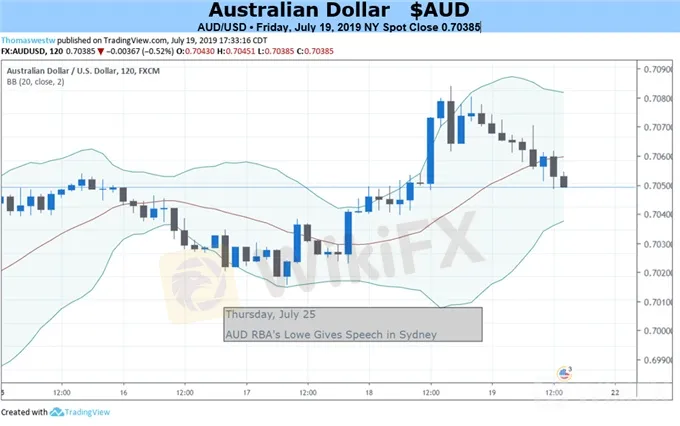简体中文
繁體中文
English
Pусский
日本語
ภาษาไทย
Tiếng Việt
Bahasa Indonesia
Español
हिन्दी
Filippiiniläinen
Français
Deutsch
Português
Türkçe
한국어
العربية
Australian Dollar Gains Should Hold As Markets Still Think Fed Will Cut
Abstract:The Australian Dollar has shared fully in the broad US Dollar weakness seen as markets become more certain that US rates are going lower.
{1}

Fundamental Australian Dollar Forecast: Bullish
{1}
The prognosis of lower US rates continues to support the Greenback
美国较低利率的预测继续支持美元
The Aussie has props of its own, not least in ongoing labor market strength
澳元拥有自己的道具,尤其是持续的劳动力市场实力
Its hard to see a near-term AUDUSD reversal, unless US data make rate cuts less likely
很难看到近期的澳元兑美元逆转,除非美国数据降息的可能性降低
Find out what retail foreign exchange traders make of the Australian Dollars prospects right now, in real time, at the DailyFX Sentiment Page
了解零售外汇交易商的情况澳大利亚元现在的前景,实时,在DailyFX情绪页面
The Australian Dollar gained on its US big brother last week, a process largely but by no means solely driven by broad weakness in the latter.
上周澳大利亚元在其美国大哥上涨,这个过程在很大程度上完全不是单纯的由后者的广泛弱点驱动。
The prime mover, obviously, is the expectation that the Federal Reserve will shortly begin to cut interest rates once again, whether or not it opts to do so at its next scheduled monetary policy conclave on July 31.
显然,原动机是期望值美联储将很快再次开始降息,无论是否在7月31日的下一次货币政策会议上选择这样做。
The Aussie does have some domestic support however.
澳元确实有然而,一些国内支持。
Australias Jobs Miracle Endures
澳大利亚的就业奇迹持久
Labor market data released on July 18 showed an underwhelming headline net increase of just 500 jobs for June. However, there was a lot more cheer in the detail which showed an encouraging surge in full-time work as well as a steady participation rate. Investors know that the Reserve Bank of Australia places special emphasis on these numbers when it meets to set rates. The latest figures show that Australias enviable record of strong job creation endures.
7月18日公布的劳动力市场数据显示总体净增长不足6月只有500个工作岗位。然而,细节更加欢呼,表明全职工作激增,参与率稳定。投资者知道澳大利亚储备银行在设定汇率时会特别强调这些数字。最新数据显示,澳大利亚令人羡慕的创造就业机会令人羡慕。
Moreover there is a suspicion that, after back to back monthly rate cuts in June and July, the RBA has done all it intends to do on that front. Unless there is absolutely no sign that inflation is picking up, further cuts may be unlikely given the astonishing indebtedness of Australian consumers, understandable though it is after years of record-low borrowing costs.
此外,有人怀疑,在6月和7月连续几个月降息后,澳联储已经做到了所有它打算在那方面做。除非绝对没有迹象显示通胀正在上升,否则鉴于澳大利亚的负债惊人,可能不会进一步削减通胀消费者,虽然经过多年的低成本借贷成本后仍然可以理解。
The coming week is likely to see continued emphasis on the ‘USD’ side of the AUDUSD pair, with Fed commentary at its usual premium. Domestically markets will get a look at Julys timely Purchasing Managers Indexes for Australia.
未来一周可能会继续强调澳元兑美元对美元兑美元汇率以其通常的溢价评论。国内市场将及时了解7月份澳大利亚的及时采购经理人指数。
Two RBA Leaders Due to Speak
两名澳大利亚央行领导人发言
Theres also a speech from RBA Governor Philip Lowe due, on Thursday. Assistant Governor Christopher Kent will speak on Tuesday.
Theres a a澳大利亚央行行长Philip Lowe周四致辞。助理行长克里斯托弗肯特将于周二发表讲话。
It‘s possible that either or both of them will have something to say about the Australian Dollar’s recent bounce from its 2019 lows. A resurgent currency wont be much help when it comes to juicing inflation, as it will keep the price of imports down.
他们中的任何一方或两方都有可能对澳元兑美元近期从2019年的低点反弹有所说明。在通货膨胀方面,复苏货币不会有太大帮助,因为它会降低进口价格。
However, given that the underlying source of this bounce has been broad US Dollar weakness, they seem unlikely to fight it too hard. The RBA is notably pragmatic about such things.
然而,鉴于此反弹的潜在来源是广泛的美元疲软,他们似乎不太可能过于努力。澳大利亚央行对这些事情非常务实。
On balance then, the Aussie looks likely to continue to gain, unless the US data round puts near-term rate cuts there in doubt. Its a bullish call this week.
总而言之,澳元看起来可能继续上涨,除非美国数据回合对近期降息有疑问。这是本周的看涨电话。

Disclaimer:
The views in this article only represent the author's personal views, and do not constitute investment advice on this platform. This platform does not guarantee the accuracy, completeness and timeliness of the information in the article, and will not be liable for any loss caused by the use of or reliance on the information in the article.
Read more

FED meeting minutes strongly hint at a rate cut in September; US dollar index falls to new low this year!
The U.S. Bureau of Labor Statistics revised down the employment growth in the year ending in March by 818,000, an average monthly decrease of about 68,000, the largest downward revision since 2009. The substantial downward revision of employment data re-emphasized the severity and necessity of the U.S. employment problem, paving the way for a rate hike in September. Bearish for the U.S. dollar.

What new signals does the Federal Reserve have? FED Governor Michelle Bowman reiterates the risk of inflation!
Fed Governor Bowman: There are upside risks to inflation, the labor market continues to strengthen, and a cautious attitude will be maintained at the September meeting. Boston Fed President Collins: If the data is as expected, it would be appropriate to start easing policy "soon". Inflationary pressure will slow down the pace of U.S. interest rate cuts, which will be bullish for the dollar.

RBA and BoE Take Center Stage Amidst U.S. Light Week
During the March meeting, Australia's central bank kept its interest rates steady at 4.35% and adopted a more relaxed approach towards tightening, suggesting growing confidence in inflation reaching its target despite economic deceleration. During the last meeting, the Bank of England maintained its interest rate at 5.25%. Governor Andrew Bailey emphasized the importance of ensuring that inflation returns to the 2% target and remains there, stating that the current situation does not warrant

GEMFOREX - weekly analysis
The week ahead: Traders on the backfoot ahead of a quiet week
WikiFX Broker
Latest News
Interactive Brokers Expands Crypto Trading with Solana, XRP, Cardano, and Dogecoin
SEC Ends Crypto.com Probe, No Action Taken by Regulator
Why More People Are Trading Online Today?
Fidelity Investments Explores Stablecoin Innovation in Digital Assets Sector
How Crypto Trading Transforms FX and CFD Brokerage Industry
UK would not hesitate to retaliate against US tariffs - No 10 sources
Gold Surges to New Highs – Is It Time to Buy?
Bitpanda Secures Full Broker-Dealer License in Dubai
Lost Money to Scam Recently?! This Article Could Help You!
Navigating the Intersection of Forex Markets, AI Technology, and Fintech
Currency Calculator







